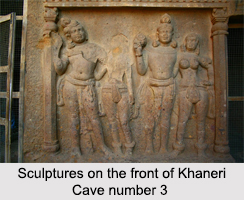 The Kanheri caves served the principles of Buddhist centres of education, where the sacred people used to convey speeches on the spiritual texts and essential ethical values. These rock cut monuments serve as a major tourist spot for the visitors in Mumbai who get enchanted with the architecture of these monuments. Khaneri caves are one of the major historical sites that reflect the Buddhist influence on the art and culture of India. These caves derive their name from the Sanskrit word "Krishnagiri" which means a hill which is black in colour.
The Kanheri caves served the principles of Buddhist centres of education, where the sacred people used to convey speeches on the spiritual texts and essential ethical values. These rock cut monuments serve as a major tourist spot for the visitors in Mumbai who get enchanted with the architecture of these monuments. Khaneri caves are one of the major historical sites that reflect the Buddhist influence on the art and culture of India. These caves derive their name from the Sanskrit word "Krishnagiri" which means a hill which is black in colour.
The rock cut temples of Khaneri caves number up to 109 small temples which used to be Buddhist Viharas that served as residences of Buddhists monks. The pleasant atmosphere of the Khaneri caves was well utilized for meditation and literary purposes which formed the base of Buddhist Monastery. The inscriptions on various rock edicts claim the Krishnagiri or Khaneri caves attracted a number of scholars from all over the world which include scholars like Ptolemy who visited the caves in 2nd century BC.
Location of Khaneri caves
Khaneri caves are the relics of ancient Buddhist monastery that is located in the north of Borivali in the western outskirts of Mumbai. This is surrounded by Sanjay Gandhi national park.
Etymology of Khaneri caves
 The word "Kanheri" has been derived from the Sanskrit word "Krishnagiri" which accurately means Black Mountain. It was named so because of its black basaltic stone.
The word "Kanheri" has been derived from the Sanskrit word "Krishnagiri" which accurately means Black Mountain. It was named so because of its black basaltic stone.
History of Khaneri Caves
It is normally supposed that Buddhism first appeared in Aparantha at Sopara which is very close to Kanheri. The caves were dig up as early as mid 3rd century B.C. and were in work right up to 11th century A.D. They were stated by early visitors like the Portuguese in the 16th century A.D. and other travellers and explorers of Europe.
Of the numerous donor messages found here reveal the ancient cities like Suparaka, Nasika, Chemuli, Kalyana and Dhenukakata are found. The contributors were from all the classes of the society, from the members of the majestic families to the commoners. The prominent among the royal families mentioned in the inscriptions are Gautamiputra Satakarni, Vasisthiputra Sri Pulumavi, Sri Yajna Satakarni, Madhariputra Sakasena and the rulers of Satavahana dynasty.
Elements of Khaneri caves
The caves are usually small in size, consisting of a single chamber with a front pillared verandah approached by a getaway of steps. The most famous among the digs at Kanheri is the Cave 3, which is a chaitya griha which was excavated during the period of Yajna Satakarni. There are proofs of wooden beams to the arched ceiling of nave which are vanished now. The pillars of the hall are not identical and of different styles and shapes which are devoid of balance. A stupa is present at the apse of the hall which measures 4.9 m in diameter and 6.7 m in height. The cover-up of the hall is pierced by three doors with two groups of two couples; each group is carved in the rectangle breaks between the doors. The side walls are sculpted broadly with two gigantic images of standing Buddha in varada mudra and other bodhisattva images.
Cave 1 is an uncompleted chaitya griha which was initially planned to have a double-storeyed verandah and a terrace, separate from the pillared hall. Cave 11 is also known as "Darbar Hall" that consists of a vast hall with a verandah. The hall has a place of worship on its back wall and cells on the two sides. The small stone benches of the floor of the two halls resemble the Cave 5 of Ellora. The sculptural art here can be seen in Caves number 2, 3, 41, 67, 89, 90, etc. The image of Buddha is usually exposed either standing or in seated position.
Attractions of Khaneri caves
There are a lot to see in and around the caves. The cave houses 34 unfinished Buddhist paintings and the prayer hall represents the Buddhist way of life and culture. There are designed tours of adventure sports like trekking around the Sanjay Gandhi National Park in which the caves are located. Since the caves are situated on hilly terrain, there are also some small waterfalls to see. The natural rivers and water bodies around the caves form a soothing and beautiful environment and is the wonderful location to take pleasure in a small picnic with family.
Visiting information of Khaneri caves
The Kanheri Caves are one of the most popular tourist destinations in Mumbai. The visitors can reach this place with the local transport. Once at the national park, visitors can also make a decision to trek to the Kanheri Caves or to choose for paid transport within the park. The Borivali and Malad stations are the nearby points to get to the Kanheri Caves. From here, visitors can opt for local transport to take them to the Kanheri Caves.




